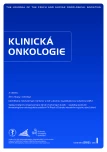Identification of Molecular Markers in Children with Acute Myeloid Leukemia (AML)
Authors:
D. Ilenčíková 1; J. Sýkora 2; Z. Mikulášová 2; Vanda Repiská 3
Authors‘ workplace:
2. Detská klinika, LF UK a DFNsP, Bratislava, Slovenská republika
1; Oddelenie onkologickej genetiky, Národný onkologický ústav, Bratislava, Slovenská republika
2; Ústav lekárskej biológie, genetiky a klinickej genetiky, LF UK a UNB, Bratislava, Slovenská republika
3
Published in:
Klin Onkol 2012; 25(1): 26-35
Category:
Original Articles
Overview
Backgrounds:
AML is an aggressive, phenotypically and genetically heterogenous clonal disease of hematopoietic progenitor cells with a great molecular variability. New WHO classification 2008 divides de novo AML according to cytogenetic and molecular prognostic and predictive markers. Recently, it is increasingly possible to identify a subgroup of poorer prognosis patients among those with normal karyotype AML. The aim of our study was to identify prognostically important molecular markers in children with AML, to stratify patients with normal karyotype and to monitor the disease according the genetic findings.
Material and Methods:
In 2008–2010, we analyzed bone marrow and peripheral blood samples of 20 children with de novo AML by conventional cytogenetic analysis, fluorescence in situ hybridisation and molecular diagnostics. The molecular analysis was performed on the cDNA level, with the restriction analysis of PCR products (FLT3-TKD), conventional PCR (MLL-PTD, NPM1mut, FLT3-ITD) and quantification RT-PCR method (expression of fusion transcripts, BAALC, WT1).
Results:
Samples from 20 children with AML were analyzed using the conventional cytogenetics, FISH and molecular methods. Abnormal karyotype was identified in 13 patients (65%). Further analysis revealed FLT3-ITD in 5/20 (25%), FLT3-TKD in 3/20 (15%), NPM1mut in 2/20 (10%) and MLL-PTD in 1/20 (5%), overexpression of WT1 gene in 15/20 (75%) and overexpression of BAALC in 13/20 (65%) patients.
Conclusion:
Wide cytogenetic and molecular screening helped to find at least one genetic marker in all 20 patients for later follow-up and risk stratification. 4/20 (20%) patients died of the disease progression.
Key words:
acute myeloid leukemia – genetic methods – mutation screening of FLT3 – NPM1 and MLL – WT1 and BAALC expression
The authors declare they have no potential conflicts of interest concerning drugs, products, or services used in the study.
The Editorial Board declares that the manuscript met the ICMJE “uniform requirements” for biomedical papers.
Submitted:
10. 5. 2011
Accepted:
22. 11. 2011
Sources
1. Kubisz P et al. Hematológia a transfuziológia. 1. vyd. Bratislava, Praha: Grada 2006.
2. Nováková P, Ilenčíková D. Genetické metódy v onkológii. Onkologia 2010; 5(2): 59–63.
3. Vardiman JW, Thiele J, Arber DA et al. The 2008 revision of the World Health Organization (WHO) classification of myeloid neoplasms and acute leukemia: rationale and important changes. Blood 2009; 114(5): 937–951.
4. Kaušitz J et al. Onkológia. 1. vyd. Bratislava: VEDA 2003.
5. Sršeň Š, Sršňová K. Základy klinickej genetiky a jej molekulárna podstata. 4. vyd. Martin: Osveta 2005.
6. Vojtašák K et al. Vybrané kapitoly z lekárskej biológie a humánnej genetiky. 1. vyd. Bratislava: Univerzita Komenského 2003.
7. Remick DG, Kunkel SL, Holbrook EA et al. Theory and applications of the polymerase chain reaction. Am J Clin Pathol 1990; 93 (4 Suppl 1): S49–S54.
8. Templeton NS. The polymerase chain reaction. History, methods, and applications. Diagn Mol Pathol 1992; 1(1): 58–72.
9. Valasek MA, Repa JJ. The power of real-time PCR. Adv Physiol Educ 2005; 29(3): 151–159.
10. Estey E, Döhner H. Acute myeloid leukaemia. Lancet 2006; 368(9550): 1894–1907.
11. Krauter J, Wagner K, Schäfer I et al. Prognostic factors in adult patients up to 60 years with AML and translocations of chromosome band 11q23: individual patient data-based meta-analysis of the German AML Intergroup. J Clin Oncol 2009; 27(18): 3000–3006.
12. Meshinchi S, Alonzo TA, Stirewalt DL et al. Clinical implications of FLT3 mutations in pediatric AML. Blood 2006; 108(12): 3654–3661.
13. Reneville A, Roumier C, Biggio V et al. Cooperating gene mutations in acute myeloid leukemia: a review of the literature. Leukemia 2008; 22(5): 915–931.
14. Balgobind BV, Hollink IH, Reinhardt D et al. Low frequency of MLL-partial tandem duplications in paediatric acute myeloid leukaemia using MLPA as a novel DNA screenings technique. Eur J Cancer 2010; 46(10): 1892–1899.
15. Hollink IH, van den Heuvel-Eibrink MM, Zimmermann M et al. Clinical relevance of Wilms tumor 1 gene mutations in childhood acute myeloid leukemia. Blood 2009; 113(23): 5951–5960.
16. Hollink IH, Zwaan CM, Zimmermann M et al. Favorable prognostic impact of NPM1 gene mutations in childhood acute myeloid leukemia, with emphasis on cytogenetically normal AML. Leukemia 2009; 23(2): 262–270.
17. Blaise A et al. WT1 Overexpression after Induction Therapy in Children AML is Associated with Higher Risk of Relapse. Blood ASH Annual Meeting 2004; 104: Abstract 2998.
18. Leukaemia § lymphoma research. Available from: http://www.llresearch.org.uk/en/1/infdispataml.html.
Labels
Paediatric clinical oncology Surgery Clinical oncologyArticle was published in
Clinical Oncology

2012 Issue 1
- Metamizole at a Glance and in Practice – Effective Non-Opioid Analgesic for All Ages
- Possibilities of Using Metamizole in the Treatment of Acute Primary Headaches
- Metamizole in perioperative treatment in children under 14 years – results of a questionnaire survey from practice
- Obstacle Called Vasospasm: Which Solution Is Most Effective in Microsurgery and How to Pharmacologically Assist It?
- Metamizole vs. Tramadol in Postoperative Analgesia
Most read in this issue
- Venous Access Devices in Oncology
- Utilisation of Electrical Impedance Tomography in Breast Cancer Diagnosis
- Identification of Molecular Markers in Children with Acute Myeloid Leukemia (AML)
- Six-year Follow-up of a Patient with Multiple Angiomatosis Involving Skeleton, Thoracic and Abdominal Cavities and the Gut Wall
